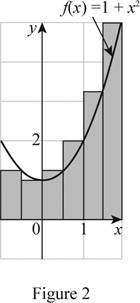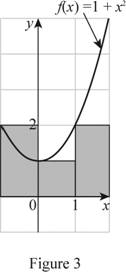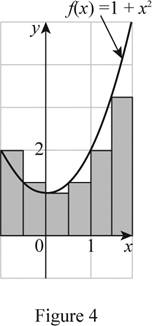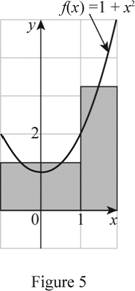
Concept explainers
(a)
To find:
The area under the graph using right endpoints and three rectangles and then area under the graph using right endpoints and six rectangles.
(a)
Answer to Problem 5E
The area under the graph using right endpoints and three rectangles is 8 and the area under the graph using right endpoints and six rectangles is 6.875.
Explanation of Solution
Given:
The curve function is
The region lies between
Calculation:
Draw the graph for the function

The expression to find the estimate of the areas of n rectangles
Here, the right endpoint height of the first rectangle is
Find the width
Here, the upper limit is b, the lower limit is a, and the number of rectangles is n.
Find the area estimate for three rectangles with right end points.
Substitute 2 for b, -1 for a, and 3 for n in Equation (2).
From Figure (1), take the right endpoint height of the first rectangle’s
Substitute 3 for n, 1 for
Therefore, the estimate using right endpoints for
Draw the graph for the function

Find the area estimate for six rectangles with right end points.
Substitute 2 for b, -1 for a, and 6 for n in equation (2).
From Figure (2), take the right endpoint height of the rectangle’s
Substitute 6 for n, and the above height of the rectangle’s in equation (1),
Therefore, the estimate using right endpoints for
(b)
The area under the graph using left endpoints and three rectangles and then area under the graph using left endpoints and six rectangles.
(b)
Answer to Problem 5E
The area under the graph using left endpoints and three rectangles is 5 and then area under the graph using left endpoints and six rectangles 5.375.
Explanation of Solution
Draw the graph for the function

The expression to find the estimate of the areas of n rectangles
Here, the left endpoint height of the first rectangle is
Find the area estimate for three rectangles with left end points:
From Figure (3), take the left endpoint height of the first rectangle’s
Substitute 3 for n, and the above height of the rectangle’s in equation (3),
Therefore, the estimate using left endpoints for
Draw the graph for the function

Find the area estimate for six rectangles with left end points:
From Figure (4), take the left endpoint height of the rectangle’s
Substitute 6 for n, 2 for
Therefore, the estimate using left endpoints for
(c)
The area under the graph using midpoints and three rectangles and then area under the graph using midpoints and six rectangles.
(c)
Answer to Problem 5E
The area under the graph using midpoints is 5.75 and three rectangles and then area under the graph using midpoints and six rectangles is 5.95.
The area under the graph using mid points and three rectangles is 5.75.
The area under the graph using mid points and six rectangles is 5.95.
Explanation of Solution
Draw the graph for the function

The expression to find the estimate of the areas of n rectangles
Here, the midpoint height of the first rectangle is
From Figure (5), take the right endpoint height of the rectangle’s
Substitute 3 for n, and the above height of the rectangle’s in equation (4),
Therefore, the estimate using midpoints for
Draw the graph for the function

Find the area estimate for six rectangles with midpoints:
From Figure (6), take the right endpoint height of the rectangle’s
Substitute 6 for n, and the above height of the rectangle’s in equation (4),
Therefore, the estimate using midpoints for
(d)
To find:
The best estimate.
(d)
Answer to Problem 5E
The midpoint estimate value seems to be the best estimate.
Explanation of Solution
Analyze the best estimate among the estimates:
From part (a), part (b), and part (c), the estimates using right endpoints with three and six rectangles shows an overestimate of the true area and the estimate using left endpoints shows an underestimate of the true area.
The mid estimate of the area using midpoints with three and six rectangles shows the area of each rectangle which appears closer to the true area.
Hence, the mid estimate represents to the best estimate
Chapter 5 Solutions
Single Variable Calculus: Concepts and Contexts, Enhanced Edition
 Calculus: Early TranscendentalsCalculusISBN:9781285741550Author:James StewartPublisher:Cengage Learning
Calculus: Early TranscendentalsCalculusISBN:9781285741550Author:James StewartPublisher:Cengage Learning Thomas' Calculus (14th Edition)CalculusISBN:9780134438986Author:Joel R. Hass, Christopher E. Heil, Maurice D. WeirPublisher:PEARSON
Thomas' Calculus (14th Edition)CalculusISBN:9780134438986Author:Joel R. Hass, Christopher E. Heil, Maurice D. WeirPublisher:PEARSON Calculus: Early Transcendentals (3rd Edition)CalculusISBN:9780134763644Author:William L. Briggs, Lyle Cochran, Bernard Gillett, Eric SchulzPublisher:PEARSON
Calculus: Early Transcendentals (3rd Edition)CalculusISBN:9780134763644Author:William L. Briggs, Lyle Cochran, Bernard Gillett, Eric SchulzPublisher:PEARSON Calculus: Early TranscendentalsCalculusISBN:9781319050740Author:Jon Rogawski, Colin Adams, Robert FranzosaPublisher:W. H. Freeman
Calculus: Early TranscendentalsCalculusISBN:9781319050740Author:Jon Rogawski, Colin Adams, Robert FranzosaPublisher:W. H. Freeman
 Calculus: Early Transcendental FunctionsCalculusISBN:9781337552516Author:Ron Larson, Bruce H. EdwardsPublisher:Cengage Learning
Calculus: Early Transcendental FunctionsCalculusISBN:9781337552516Author:Ron Larson, Bruce H. EdwardsPublisher:Cengage Learning





